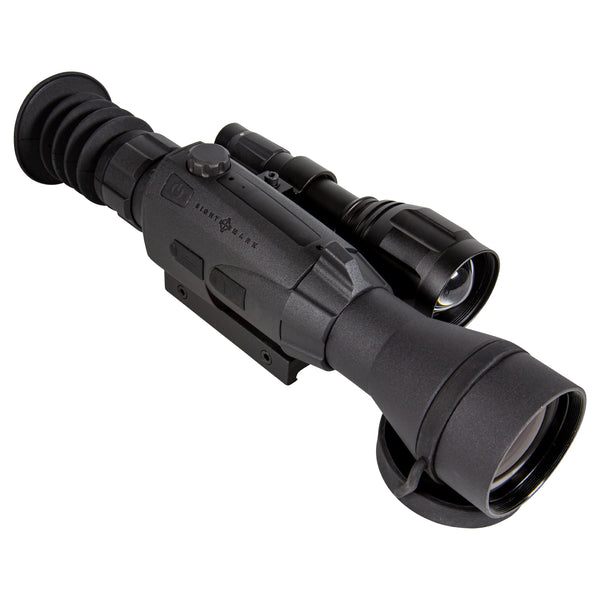Back in the day, every hunt, every stakeout, and every commando raid had to either end at sundown or be carried out with grave risks. However, with night vision becoming more commonplace—even among civilians—the darkness of the night has become much less of a hindrance. Night vision technology has transformed the unseen into something visible and actionable. But not all night vision is created equal. Whether you are a hunter tracking elusive prey under the cover of night, a tactical shooter scanning the terrain for potential threats, or a law enforcement officer on patrol, understanding the types of night vision—generational, digital, and thermal—is essential to choosing the right tool for the job. Each type offers distinct advantages and drawbacks that can determine the effectiveness of your nighttime pursuits.
Generational Night Vision
Many people associate night vision with the high-pitched hum often heard in movies when someone turns on their night vision device. However, this sound was primarily a feature of very early generational night vision, and modern night vision devices operate completely silently. The sound originated from the high-voltage power supply used to amplify the electrons generated by incoming light, a necessary step in early technology to enhance the image. Today's advanced night vision optics have eliminated this noise, making them completely silent in operation, which is a crucial advantage in tactical and hunting scenarios where stealth is key.
With that in mind, generational night vision remains the most well-known and widely used type of night vision technology, frequently used by both military and law enforcement tactical teams. This technology works by amplifying ambient light, such as moonlight or starlight, to produce a visible image with its signature green hue. The quality and performance of generational night vision vary based on the generation classification.
Generational night vision is expensive as a rule, but Gen 1 night vision is the most basic and budget-friendly option, making it accessible for those new to night vision optics, running between the $1,000 - $2,000 range on average. However, since it works by amplifying light, it requires a light source to function properly and tends to produce grainy images in complete darkness. Gen 2 significantly improves clarity, brightness, and range, making it an ideal choice for serious hunters and law enforcement professionals who need reliability without the steep cost of military-grade optics. Gen 3 and 4 night vision represent the pinnacle of this technology, offering superior image clarity, exceptional low-light performance, and increased durability. These high-end models are favored by military and law enforcement personnel due to their ability to function effectively even in near-total darkness. However, their premium performance comes with a hefty price tag, often ranging from $3,000 to well over $10,000 for top-tier Gen 3 and Gen 4 models.
The main advantages of generational night vision include its real-time viewing with no digital lag, reliable long battery life, and superior depth perception compared to digital alternatives. However, these devices can be expensive, especially at higher generations, and they are sensitive to bright light exposure, which can permanently damage internal components. Additionally, they lack recording capabilities and color display options, limiting their versatility.

Digital Night Vision
Unlike traditional generational night vision, digital night vision replaces light amplification tubes with electronic sensors and image processing technology. This shift results in a more versatile optic that functions effectively in both day and night conditions. Digital night vision often includes features such as full-color display, recording capabilities, and the ability to capture photos, making it an appealing choice for hunters and tactical shooters looking for an all-in-one solution.
One of the key benefits of digital night vision is its ability to operate without risk of damage from bright light exposure. Traditional night vision can be permanently damaged by sudden exposure to high-intensity light, whereas digital models can transition between light conditions without issue. Additionally, digital optics are generally more affordable than high-end Gen 2 and Gen 3 night vision, making them an attractive choice for budget-conscious users.
However, digital night vision is not without its drawbacks. Because it relies on electronic sensors, there can be a slight digital lag when tracking fast-moving targets. Additionally, these devices consume more power, requiring users to carry extra batteries for extended use. Depth perception is also slightly reduced compared to traditional night vision, which can be a consideration for those who rely on precise spatial awareness in the field.
Thermal Night Vision
Thermal imaging operates on an entirely different principle than generational and digital night vision. Instead of amplifying light, thermal devices detect infrared radiation emitted by objects, allowing users to see heat signatures rather than visual details. This makes thermal optics highly effective in complete darkness, fog, smoke, or other conditions where traditional night vision would struggle.
The primary advantage of thermal imaging is its ability to detect living creatures regardless of their surroundings. Whether a target is hiding behind brush or camouflaged against the landscape, thermal imaging picks up its heat signature, giving hunters and tactical shooters a critical advantage. Additionally, thermal devices are not affected by light exposure, meaning they can be used in bright environments without issue.

Wraith 4K Mini 2-16x32 Digital Riflescope
The Wraith 4K Mini Digital Riflescope combines Sightmark’s rugged quality with advanced digital optic technology, featuring a 4K (3840x2160) CMOS sensor and a detection range of up to 300 yards in low-light conditions.

Wraith 4K Max 3-24x50 Digital Riflescope
The Wraith 4K Max digital riflescope offers an ultra-high-definition 4000x3000 digital CMOS sensor, detecting objects up to 300 yards away in low-light conditions, and features a 3-24x digital magnification.

Wraith 4K 4-32x40 Digital Riflescope
Sightmark Wraith 4K 4-32x40 day/night digital riflescope boasts a 4K (3840x2160) CMOS sensor, full-color HD daytime imaging, digital night vision.
However, thermal imaging has its downsides. These optics tend to be more expensive than digital or Gen 1/2 night vision, making them a significant investment. Additionally, thermal optics do not provide fine details or facial recognition, as they primarily display heat signatures in various color palettes. Another consideration is battery consumption, as thermal devices typically require more power and may not last as long in the field without extra batteries.
Which Type of Night Vision is Right for You?
Choosing the right night vision technology depends on your specific needs and budget. Hunters looking for an affordable option with solid clarity should consider digital night vision, while those needing an edge in difficult terrain and unpredictable conditions might benefit from thermal imaging. Tactical users who require reliable, real-time imaging will find that higher-end generational night vision provides the best balance of performance and durability. Law enforcement professionals often favor Gen 3 night vision or thermal optics to enhance situational awareness in both urban and rural environments.
Enter the Wraith Mini and Wraith Mini Thermal
With a better understanding of night vision technology, it’s time to talk about gear. The Sightmark Wraith Mini is an advanced digital riflescope designed for hunters and tactical shooters who demand versatility. Able to switch between full-color daytime mode and digital night vision, this lightweight, compact scope ensures clear imaging in any lighting condition. Additionally, it includes recording capabilities, allowing users to document their shots and review their hunts with ease.
For those interested in thermal technology without breaking the bank, the Wraith Mini Thermal stands out as one of the most affordable thermal riflescopes on the market. At only $1,499.99, the Wraith Thermal offers high-resolution heat detection, multiple color palettes, and a streamlined design, providing hunters and tactical users with superior night vision capabilities in a compact package.
Final Thoughts
No matter your preference—whether it's traditional night vision, digital technology, or cutting-edge thermal imaging—there is a night vision solution tailored to your needs. Investing in the right optic can make all the difference when it comes to successful nighttime hunting, tactical operations, or security monitoring. If you’re looking for an all-around reliable solution, the Wraith Mini and Wraith Mini Thermal offer some of the best features at an unbeatable price point.
Shop Sightmark's night vision collection here.
Check out the Wraith Thermal here.
Frequently Asked Questions
What are the three main types of night vision technology?
The three main types of night vision technology are generational night vision, digital night vision, and thermal imaging.
How does generational night vision work?
Generational night vision works by amplifying ambient light, such as moonlight or starlight, to produce a visible image with a green hue.
What is the price range for Gen 1 night vision devices?
Gen 1 night vision devices typically range between $1,000 to $2,000, making them a budget-friendly option for those new to night vision optics.
Why is stealth important in tactical and hunting scenarios involving night vision technology?
Stealth is important in these scenarios because it allows the user to remain undetected by their targets, increasing their chances of success.
What are the advantages of Gen 3 and Gen 4 night vision technology?
Gen 3 and Gen 4 night vision technology offer superior image clarity, exceptional low-light performance, and increased durability, making them ideal for military and law enforcement use.




